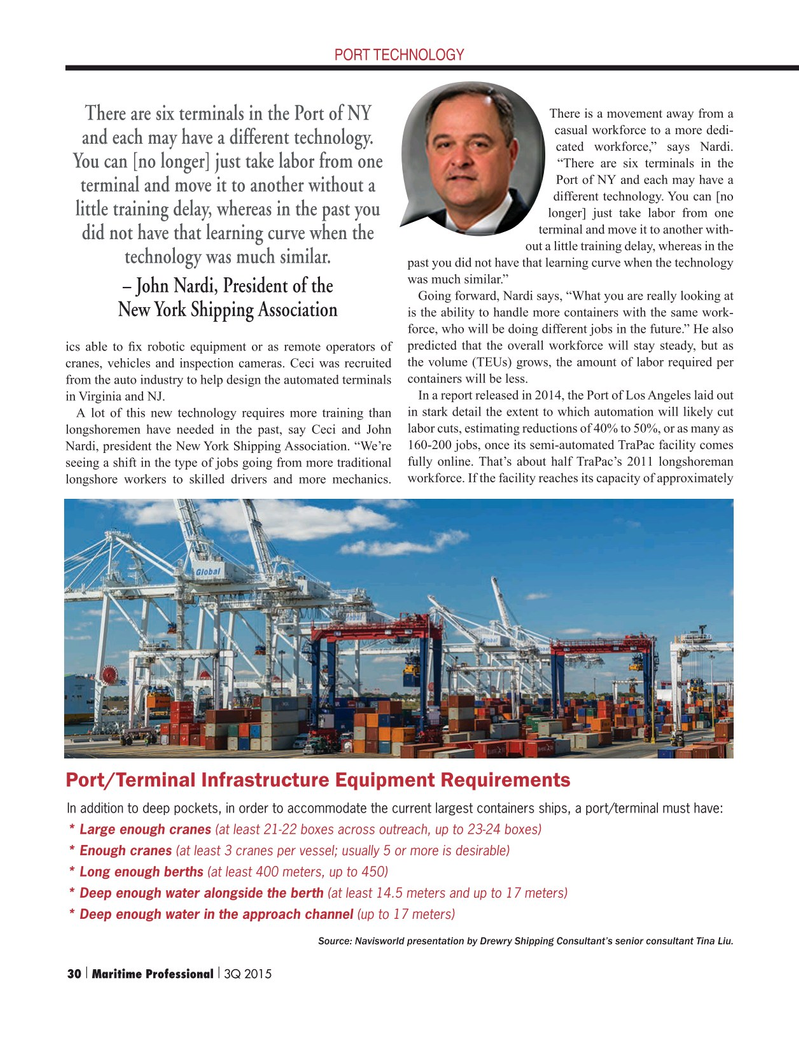
Page 30: of Maritime Logistics Professional Magazine (Q3 2015)
Read this page in Pdf, Flash or Html5 edition of Q3 2015 Maritime Logistics Professional Magazine
PORT TECHNOLOGY
There is a movement away from a
There are six terminals in the Port of NY casual workforce to a more dedi- and each may have a different technology. cated workforce,” says Nardi. “There are six terminals in the
You can [no longer] just take labor from one
Port of NY and each may have a terminal and move it to another without a different technology. You can [no little training delay, whereas in the past you longer] just take labor from one terminal and move it to another with- did not have that learning curve when the out a little training delay, whereas in the technology was much similar.
past you did not have that learning curve when the technology was much similar.” – John Nardi, President of the
Going forward, Nardi says, “What you are really looking at
New York Shipping Association is the ability to handle more containers with the same work- force, who will be doing different jobs in the future.” He also ics able to ? x robotic equipment or as remote operators of predicted that the overall workforce will stay steady, but as cranes, vehicles and inspection cameras. Ceci was recruited the volume (TEUs) grows, the amount of labor required per from the auto industry to help design the automated terminals containers will be less.
in Virginia and NJ. In a report released in 2014, the Port of Los Angeles laid out
A lot of this new technology requires more training than in stark detail the extent to which automation will likely cut longshoremen have needed in the past, say Ceci and John labor cuts, estimating reductions of 40% to 50%, or as many as
Nardi, president the New York Shipping Association. “We’re 160-200 jobs, once its semi-automated TraPac facility comes seeing a shift in the type of jobs going from more traditional fully online. That’s about half TraPac’s 2011 longshoreman longshore workers to skilled drivers and more mechanics. workforce. If the facility reaches its capacity of approximately
Port/Terminal Infrastructure Equipment Requirements
In addition to deep pockets, in order to accommodate the current largest containers ships, a port/terminal must have: * Large enough cranes (at least 21-22 boxes across outreach, up to 23-24 boxes) * Enough cranes (at least 3 cranes per vessel; usually 5 or more is desirable) * Long enough berths (at least 400 meters, up to 450) * Deep enough water alongside the berth (at least 14.5 meters and up to 17 meters) * Deep enough water in the approach channel (up to 17 meters)
Source: Navisworld presentation by Drewry Shipping Consultant’s senior consultant Tina Liu.
30 Maritime Professional 3Q 2015| | 18-33 Q3 MP2015.indd 30 9/18/2015 9:49:31 AM

 29
29

 31
31
